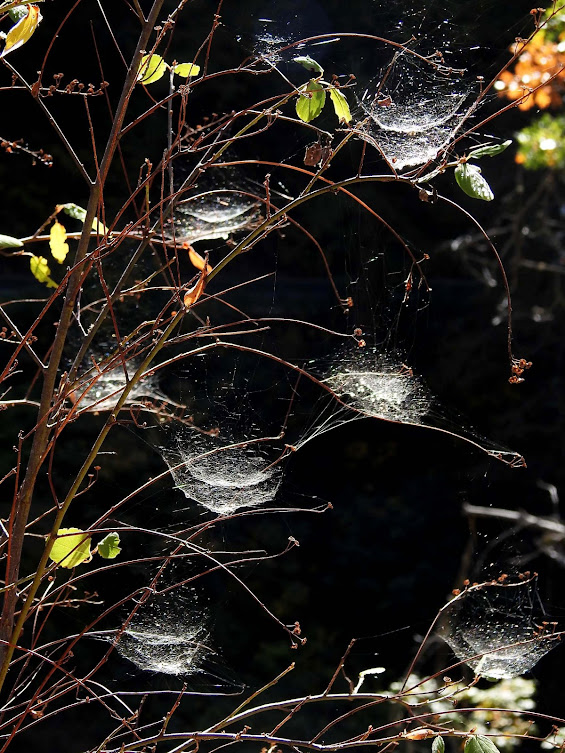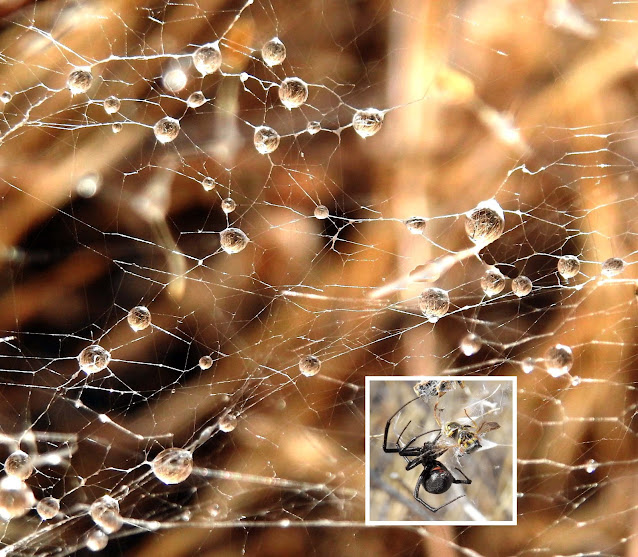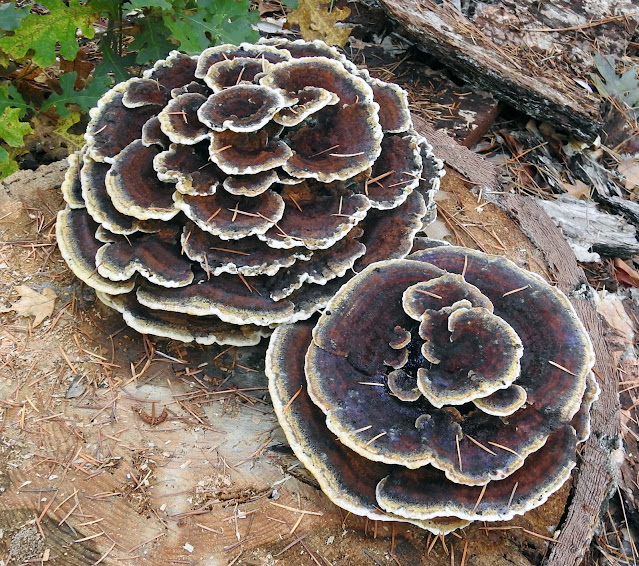Bowl & Doily spider webs - Frontinella pyramitela
One afternoon this week, we decided to go for a walk on the local Canyon Creek Trail. When we got there, the leafless shrubs were filled with the webs of sheet web spiders, all beautifully backlit by the sun! They were also filled with sparkling raindrops from the recent storm! Such Beauty!
Inspired by these spiders and their webs, and in the spirit of Halloween, I'm featuring some of the native species often thought of as "creepy" in this blog! Some of them you definitely wouldn't want to eat or touch, while on the other hand others are quite harmless. All of them are surprisingly fascinating!
Bowl & Doily spider webs & spider (inset) - Frontinella pyramitela
Spiders!
Spider webs are pretty incredible structures. Spider silk is a protein fiber that varies in structure (up to 7 different kinds) depending on its use! Most silks have exceptional mechanical properties, including high tensile strength and extensibility. A given weight of silk is five times stronger than the same weight of steel! Some spiders repair their webs at night. Others eat their web and rebuild it daily! Some spiders, such as the Crab Spider, don't build webs at all and rely on camouflage and ambush to catch their prey!
Bowl & Doily Spiders are sheet web weavers. Sheet webs are horizontally spun, flat sheets of silk between tufts of grass or tree branches. These webs are made with individual strands or are woven as a thick sheet of silk, and the spider will also spin separate criss-crossed threads about the sheet. There are over 4, 600 species of sheet web weavers in the world! They are very tiny and don't use sticky thread, but rather entangle and snare prey in their dense webs.
Black Widow Spider - Latrodectus hesperus
After seeing the female Black Widow Spider pictured above, I was wondering if all spiders have venom. It turns out that except for two small groups in the arachnid family, all spiders have poison glands and release their secretions into their venom sacs near their chelicerae. However, the majority of spiders do not bite humans and except for a few cases, they are not harmful to the human being or other mammals.
The Black Widow Spiders are very poisonous and should NOT be handled. Their bite can be QUITE painful, but rarely fatal. The female is shiny black with a red hourglass or dashes on its abdomen. Males are brown or gray with red spots on their abdomen!
Spiders are not insects! They are classified in the Kingdom Animalia, the Phylum Arthropoda, the Subphylum Chelicerata, and the Class Arachnida. Spiders are in the Order Araneae. The main differences between insects and spiders are that they have 8 legs (insects have 6 legs) and only 2 body parts (insects have 3 body parts).
Black Widow Spider - Latrodectus hesperus
Black widows use a silk-like substance to weave tangled-looking webs, typically close to the ground in covered or dark places, such as near drain pipes or under logs. We found several on the bottom of our bee hives!!! The female hangs upside down in the web to await her prey, exposing her bright markings as a warning to potential predators.
The black widow senses vibrations to the web. When an unlucky intruder gets trapped, the spider immediately begins weaving its glue-like webbing around it. Insects such as flies, mosquitoes, or even larger prey like grasshoppers are typically caught. Once captured, the black widow injects its victims with poison, paralyzing them.
The name “black widow” comes from the female’s habit of eating the male after mating!
Southern House Spider - Kukulcania hibernalis.
Tangle/Cobwebs are typically associated with the Theridiidae family (black widows or house spiders, for example.) These webs lack symmetry and are simply several jumbled threads supported by a base.
The spider pictured above is a female Southern House Spider, Kukulcania hibernalis. The males and females can both be up to 2" wide, but the males have longer legs and much smaller bodies.
Wikipedia states: "The female Southern House Spider weaves the same type of tangled web that a Black Widow Spider weaves. Females seldom move except to capture prey caught in their webs. Males, on the other hand, typically wander in search of insects and females to mate with, having no particular territory.
The southern house spider is a cribellate spider. That is, its spinnerets do not produce adhesive webbing. Instead, to capture prey the spider uses its legs to comb webbing across its cribellum, a spiked plate near the spinnerets. This combing action frays and tangles the strands, producing a fine, velcro-like netting that ensnares insect legs."
Orb Weaver Web
The Orb Weaver web above was made by a female spider. The female spider doesn't get stuck in her own web because she mainly travels on the non-sticky structural lines. Sometimes she has to walk on the sticky spiral lines, but her hairy legs have an oil that keeps them from sticking!
Orb Weaver Spider and Web - Family Araneidae
The female will use the web to trap insects. Once they're stuck, the female will bite the insect, wrap it in silk and wait for it to die. Once it dies, the female vomits digestive fluid over the wrapped dead insect, to soften it, then eats it by chewing and sucking!
Male Orb Weavers don't make webs. They spend their time cruising for females to mate. At this time of year, the females are laying their last clutch of eggs, and will die at the first frost. The eggs will overwinter, up to several hundred eggs in one egg sac, and hatch in the spring, The eggs will overwinter, but the female and male spiders will die at the first frost. We just had our first frost last night, so I'm glad I got these spider web photos this week!
Questionable Stropharia - Stropharia ambigua
Toadstools!
The term toadstools usually refers to fungi that have a stem and a cap and are possibly poisonous! The fungi above does have a stem and cap, and is not edible! However there are always exceptions to the rule! My personal rule is to NOT eat wild mushrooms, unless you're with a mycologist!
Since the recent rain, mushrooms have been popping up everywhere! I'm still not very good at identifying them but I love looking for them in the woods! There is a huge variety of mushrooms that grow in our neighborhood!
Last January I learned something super interesting about mushrooms! (I'm repeating that information here.) I was wondering how fast mushrooms grow, because they seem to show up overnight. One day you don't see any. The next day there's tons of them. So I did a little research and I found out that if conditions are perfect (not too hot, too cold, too wet, or too dry) most mushrooms CAN double there size in 24 hours!!! How do they do that?
Well, plants and animals grow through the process of "cell division", which is relatively slow and takes lots of energy. The underground mushroom body (the mycelium) does grow by cell division. However, the fruiting body, or mushroom, grows by "cell enlargement", not "cell division". The mushroom enlarges its cells by filling them with water! This can happen very quickly, and make it appear that a mushroom is growing super fast! The tiny "button" stage of a mushroom has almost exactly the same number of cells that the fully-grown mushroom has! This is also why mushrooms appear when it rains! Without the rain they couldn't "grow"!
Witch's Butter - Tremella mesenterica
This aptly named fungus can totally dry up and shrink in size when water/humidity is absent. As soon as it rains, it can absorb the water and swell back up again!
Club/Thumb Fungi - Spathularia neesii
These odd shaped fungi are only about half an inch tall. I've only seen them growing in wet mossy areas. They do kind of look like naked thumbs!
Shaggy Mane - Coprinus comatus
I recently revisited an area where I had seen a Shaggy Mane mushroom once before, and to my delight there was a new one sprouting in the same spot! Over the course of a few days, this mushroom will become taller and the fringes will form a cap that drips a slimy substance! What an unusual mushroom!
Dyer's Polypore - Phaeolus schweinitzii
The Dyer's Polypore pictured above is a wide as a dinner plate, and grows in stacked fluted layers! The layers are velvety and tough! It's not that common in our woods, so I was thrilled to find two of them!
On one of our local walks we came across a mound of human-disturbed earth, on which the fungi were prolific!!! There were all kinds of mushrooms growing on the mound, but I don't know what kind they were. Here are some photos of what we saw!
unknown fungi
These mushrooms were just PACKED together and very numerous!
unknown fungi
This one was a big as a dinner plate and looked like a crusty loaf of bread!
unknown fungi
These were also as big as dinner plates, and were a deep pumpkin-orange in color!
Banana Slug feasting on a Bolete! - Ariolimax buttoni
Slugs & Slime!
A variety of critters are fungivores (eaters of fungi), such as the Northern Flying Squirrel, deer, mice, voles, squirrels, beetles, and even banana slugs! Banana slugs are slimy, but they aren't poisonous to handle.
The following information about Banana Slugs is from the website https://www.firesidemotel.com/banana-slugs-traverse-our-forests.
"In its seven years of life, give or take, the banana slug spends a lot of its time eating decomposed animal and plant matter. By doing so, they help their ecosystem by excreting nitrogen-rich fertilizer, good for plants on the forest floor. They also spread the spores of mushrooms, one of their favorite foods.
During dry or drought periods, banana slugs will estivate, that is, secrete a thick coat of protective mucous around their bodies and then bury themselves in debris to wait until the environment becomes moister. They won’t emerge again until environmental conditions favor their survival.
Banana Slugs - Ariolimax buttoni
Mucous, or slime, is a critical component for banana slugs, helping them to breathe efficiently, to move and to take in water. The slime acts as a lubricant and an adhesive – hence, they can climb up trees. Pheromones released in the slime attract other slugs for mating, and the lubricant also is said to numb the tongues of predators such as garter snakes and salamanders.
Of its body features, this gastropod (the word means “stomach-foot”) has only one lung and moves by contracting muscles along its underside in tandem with its secreting slime. Of its four tentacles, the top two detect light and movement, while the lower two are for smelling and feeling. If damaged by a predator or by accident, the tentacles will grow back."
Insect-Egg Slime Mold - Leocarpus fragilis
To our surprise bright orange-yellow slime molds have been showing up in the forest this week. It's all over the place! It isn't a mold or fungus, it's a group of single-celled organisms that move around and engulf their food, mainly bacteria! The following quotation briefly explain this complex organism, and is from the website at https://www.cliffsnotes.com/study-guides/biology/microbiology/the-fungi/slime-molds.
"Slime molds have characteristics of both molds and protozoa. Under certain conditions, the slime mold exists as masses of cytoplasm, similar to amoebae. It moves over rotting logs or leaves and feeds by phagocytosis. The amoeba stage is called the plasmodium, which has many nuclei.
The amoeba stage ends when the plasmodium matures or encounters a harsh environment. At this point, it moves to a light area and develops fruiting bodies that form spores at the ends of stalks. The spores are resistant to environmental excesses. They germinate when conditions are suitable to form flagellated swarm cells, or amoeboid cells, which later fuse to again form a multinucleate plasmodium."
Dog Vomit Slime Mold - Fuliga septica
I've read about Dog Vomit Slime Mold, but I just saw one for the first time in my life a few weeks ago! They are indeed slimy and if you touch them, they dissolve! Yuck! Probably a perfect ingredient for a witches' brew!
Well, I hope you enjoyed this collection of creepy, unusual, and gross species! Pretty interesting stuff, I think! Get out there and check it out yourself, and let nature cast a spell on you!
What's happening in the Lakes Basin?
What's happening in the local Oak Woodlands?
Check back next week for the answers to these questions and more!
Your questions and comments are always appreciated! Please email me at northyubanaturalist@gmail.com. Thanks!






.JPG)
















No comments:
Post a Comment